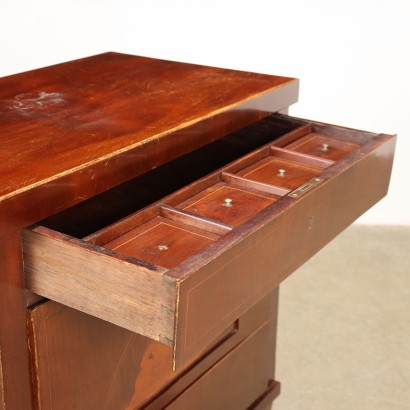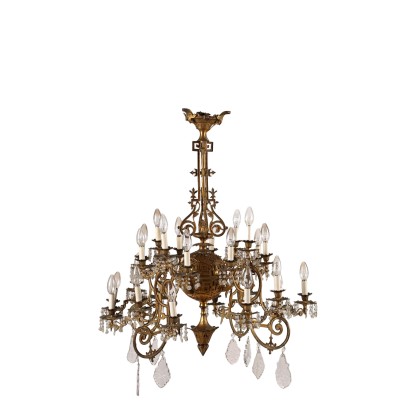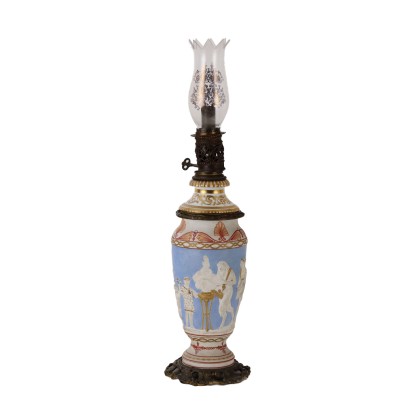Bedside Table Neoclassical Style Mahogany France XIX Century - France, Late XIX Century
Features
France, Late XIX Century
Style: Neo-Classical Revival
Age: 19th Century / 1801 - 1900
Origin: France
Main essence: Silver Fir , Maple , Mahogany , Sessile Oak
Material: Mahogany Slab , Inlaid Wood
Description
Mahogany veneered neoclassical bedside table, France, late 19th century. Front with 3 drawers, the first of which is internally divided into compartments with removable mahogany lids, front of the second drawer with demi-moon shapes with a neoclassical scene inlaid in maple. Partially threaded front in maple. Interior spruce and oak.
Product Condition:
Product that due to age and wear requires restoration and re-polishing. We try to present the real state of the furniture as fully as possible with photos. If some details are not clear from the photos, what is reported in the description will prevail.
Dimensions (cm):
Height: 79
Width: 73,5
Depth: 42
Additional Information
Style: Neo-Classical Revival
Ripresa stilistica, del 900, delle forme proprie dello stile Neoclassico ('700)Age: 19th Century / 1801 - 1900
19th Century / 1801 - 1900Main essence:
Silver Fir
Soft coniferous wood, used for rustic furniture or to build the chest, that is the structure, of furniture then veneered in more precious woods. It has been used since ancient times, its most valuable use is, in the Spruce variant, in the inlays of French antique furniture of the '700 . The spruce, more typical of northern Europe, in Italy grows mainly in the Eastern Alps at altitudes above 1300 m. The noblest use of this essence was in the construction of violins, guitars and cellos: Stradivari himself produced his famous violins with this wood.Maple
Hard, light wood used for inlays. It grows mainly in Austria, but it is widespread throughout the northern hemisphere, from Japan to North America, passing through China and Europe. It is one of the lightest woods ever, tending to white, it is similar to lime or birch wood. The briar is used in the production of ancient secretaires .Mahogany
It is one of the most precious and sought-after woods in cabinet making. It was discovered in Central America around 1600 and began to be imported to England in the 1700s. Much appreciated for its hardness and indestructibility, it became widespread following the blocking of walnut exports from France in 1720 and the consequent elimination of English import duties on mahogany from the colonies in America and India. The most valuable version comes from Cuba, but it became very expensive. At the end of the 18th century it began to be used also in France in Louis XVI, Directory and Empire furniture, its diffusion declined starting from when Napoleon, in 1810, forbade its import. It was generally used in the manufacture of elegant furniture, due to its characteristics and beautiful grain.Sessile Oak
Under the name of oak or oak various types of woods derived from plants of the genus quercus are grouped. They are always resistant, hard and compact woods. Oak is lighter than oak, both are used for more rustic furniture or for the interiors of French and English antique furniture. In other processes it was gradually replaced by the advent of exotic woods considered more valuable since the 18th century.Material:
Mahogany Slab
Inlaid Wood
Other customers have searched:
Comodino, mobile da camera, cassettiera..
Approfondimenti
Per approfondire:
Mobile portaoggetti, Inghilterra inizio XIX secolo
Uno stipo toscano a cavallo tra XVI e XVII secolo
Comò Luigi XVI attribuito a Giuseppe Viglione, Torino, fine XVIII secolo
Coppia di comò e comodino della bottega Maggiolini, 1804 ca.
Un mobile comune dalla forme inusuali
Conoscere lo stile impero
Sull'antiquariato in generale dai un'occhiata anche a
Classic Monday: da un pezzo dei nostri magazzini alla storia dell'antiquariato
L'antiquariato dalla A alla Z: il Dizionario dell'Antiquariato
Il dizionario dell'antiquariato - Lastronatura
Il dizionario dell'antiquariato - Mascherone
Il dizionario dell'antiquariato - Natura morta
Il dizionario dell'antiquariato - Opificio
Il dizionario dell'antiquariato - Pastiglia
Il dizionario dell'antiquariato - Savonarola
Il dizionario dell'antiquariato - Rosone
Approfondimenti
Per approfondire:Mobile portaoggetti, Inghilterra inizio XIX secolo
Uno stipo toscano a cavallo tra XVI e XVII secolo
Comò Luigi XVI attribuito a Giuseppe Viglione, Torino, fine XVIII secolo
Coppia di comò e comodino della bottega Maggiolini, 1804 ca.
Un mobile comune dalla forme inusuali
Conoscere lo stile impero
Sull'antiquariato in generale dai un'occhiata anche a
Classic Monday: da un pezzo dei nostri magazzini alla storia dell'antiquariato
L'antiquariato dalla A alla Z: il Dizionario dell'Antiquariato
Il dizionario dell'antiquariato - Lastronatura
Il dizionario dell'antiquariato - Mascherone
Il dizionario dell'antiquariato - Natura morta
Il dizionario dell'antiquariato - Opificio
Il dizionario dell'antiquariato - Pastiglia
Il dizionario dell'antiquariato - Savonarola
Il dizionario dell'antiquariato - Rosone






































